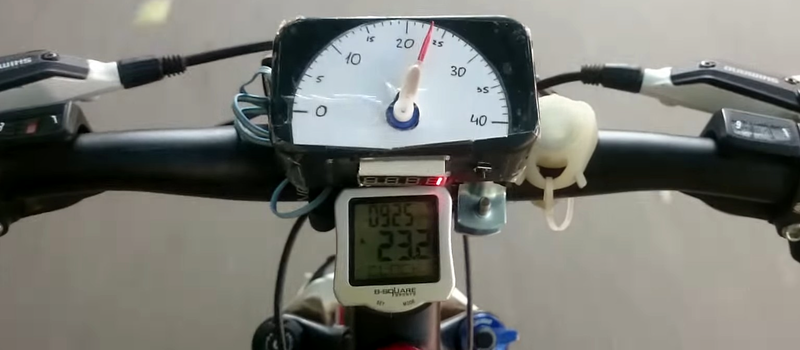It is pretty easy to go to a big box store and get a digital speedometer for your bike. Not only is that no fun, but the little digital display isn’t going to win you any hacker cred. [AlexGyver] has the answer. Using an Arduino and a servo he built a classic needle speedometer for his bike. It also has a digital display and uses a hall effect sensor to pick up the wheel speed. You can see a video of the project below.
[Alex] talks about the geometry involved, in case your high school math is well into your rear view mirror. The circumference of the wheel is the distance you’ll travel in one revolution. If you know the distance and you know the time, you know the speed and the rest is just conversions to get a numerical speed into an angle on the servo motor. The code is out on GitHub.
Granted, reading a magnet, keeping time, and driving a servo isn’t exactly cutting edge. On the other hand, it made us think about what other kinds of outputs you could drive. We haven’t seen a nixie tube speedometer (well, not on a bicycle, anyway), for example. Or maybe one built with mechanical flip numbers like an old clock.
We have seen some with Arduinos and lots of LEDs (although, again, not really for a bicycle). This speedometer might still be our favorite, though.
https://www.youtube.com/watch?v=1ycA7TFV4t4&feature=player_embedded
















Someone would break that if locked up on a bike around here.
Then you make it removable in some way.
Could do this with an ammeter, dynamo and a voltage divider: Just need to calibrate the display.
Probably going to give out exponential or logarithmic movement, So use the shop speedometer, get up to 5,10,15,20 and 25 Mph/Kmh respectively and record the needle positions at said speeds using a Head camera, or some other less dangerous method: unless you’re trying to be Evel Knievel
An easy thing would be to ride at 10km/h (which is not too dangerous) and calibrating the display using multiple magnets around the wheel, to display 20, 30, 40km/h and more. When I was a middle school kid, that was a way to brag showing speedometer recordings of over 100km/h.
How many road bumps and curbs do you think a standard ammeter head would survive?
That’d give you relative speed though, not absolute.
Maybe that’s more / just as useful anyway? When cycling into a headwind, I often wonder what m equivalent speed on a calm day would be. Obviously it would discount all other sources of friction apart from aerodynamic drag.
Waiting for the guy or gal who does this with a sports car (Porsche, Maserati, Ferrari) instrument cluster.
Give that man a 3D printer!
can be done with no hall effect sensor.. http://www.thingiverse.com/thing:531560